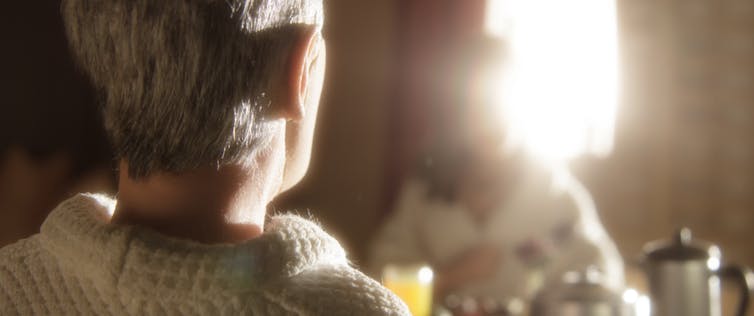Although the technique of stop-motion animation is widely used to craft strange worlds, such as those of Adam Elliot’s claymations, or Daisy Jacobs’ BAFTA-winning short The Bigger Picture (2014), it tends to be associated with commercial children’s films – the likes of Wallace and Gromit, or Fantastic Mr Fox. But Anomalisa, a stop-motion feature recently released to reams of adulatory reviews and five star ratings, is aimed at adults (rated 15 in the UK, R in the US).
This successful shift into animation by director Charlie Kaufman – famed for Being John Malkovich and Eternal Sunshine of the Spotless Mind – is a landmark move. The technique adds visual richness to a poignant story of a man who struggles to hear, see, and engage with individuals in the crowded house of humanity. Hopefully, it also augurs increased use of this versatile and exciting medium.
Written and directed by Charlie Kaufman under the pseudonym Francis Fregoli, Anomalisa was first performed as a sound play at The Theatre of the New Ear in Los Angeles. It is the story of a man who feels dislocated from the world – Kaufman’s pseudonym nodding to a condition called Fregoli delusion, in which the sufferer believes different people are a single person in disguise. Michael Stone, Anomalisa’s central character, is a middle-aged British man living in Los Angeles and visiting Cincinnati where he is to attend a conference as its keynote speaker. In his world, everybody looks and sounds alike, regardless of gender, age, race and ethnicity.

The world we are introduced to is not the colourful and wacky one that we are used to seeing animated. It is familiar. Michael arrives at the airport, gets a taxi to the hotel, checks in, goes to his room. This is a recognisable world where puppets do recognisable things. Anomalisa makes the most of stop-motion’s ability to show us a world with familiar physics and dimensions (though one always slightly askew). Sets are built to the same dimensional order as the world we inhabit, but scaled to match the foot-high puppets. And familiarity is further enhanced by the puppet design – the silicon puppets look almost anatomically correct.
Dislocation
So stop-motion effectively gives substance to a world that is recognisable, but just out of kilter. In the play, the three actors spoke their dialogue sitting simply on stools in front of an orchestra, accompanied by a foley artist creating sounds. By separating dialogue from action, and demonstrating the mechanics of sound production, the sound play evoked the dislocation felt by Michael.
The same effect is achieved in the film – aside from those of Michael and Lisa, all the puppets have the same face and are voiced by a single actor. The animated version closely follows the original script and is voiced by the same actors (David Thewlis as Michael, Jennifer Jason Lee as Lisa, and Tom Noonan as everyone else).
Stop-motion movement inevitably reveals its artifice and so is never quite human enough, increasing the effects of disjunction.

The puppets have larger than scale heads, and through the technique of rapid prototyping 3D printing, their faces are visibly constructed parts of a whole. Rapid prototyping 3D printing was first developed at the LAIKA Studio for Coraline (2009), and later Paranorman (2012) and The Boxtrolls (2014). The technique involves first generating the cheek and mouth shapes necessary for lip-sync, and also expressive changes around the eyes and forehead, as digital models. These digital models are printed out as 3D resin shapes, and placed on each puppet’s face on a shot-by-shot basis to create mobile and expressive faces.
Side-effects of 3D printing include visible seams between the different facial parts and flaws from the printing process: colour deviations between print runs and striation patterns from the horizontal layering of resin. By retaining these flaws and showing the imperfect joins across the eyes and around the hair and jaw line, Anomalisa reveals the mechanics behind the stop-motion technique, and keeps the puppets only, though weirdly, close to human.
Puppet or character?
Not surprisingly, given Anomalisa’s origin as a sound play, dialogue is important too. In a game with customer service platitudes (Michael has achieved national success as a customer service guru), there’s an over abundance of meaningless words when Michael consistently fails to engage with the taxi driver, hotel receptionist, bell hop, and room service. Even in more personal conversations with his wife and ex-girlfriend, he seems given to a bewilderment that finally collapses into impatience, distraction, or indecision.
In a lovely sequence that blurs the boundaries between the technique and the story-world, Michael is shaken by a profoundly destabilising moment in which a revelation of the mechanics of sound and stop-motion coincide. Looking at his face in the bathroom mirror, he glitches. The different moving parts of his face cease to co-ordinate and instead distort as the lip-sync fails, while his voice becomes warped and mechanical. Here, Michael is caught between puppet and character, a dilemma resonating with his experience of life.
Stop-motion’s facility to shift its audience between the registers of strangeness and familiarity is well suited to the story told by Charlie Kaufman. Given the enthusiastic reviews, it will be interesting to see whether makers of stop-motion shorts and features will have more opportunities to step out of the niche of family entertainment, and take on more diverse challenges. In its ability to render and explore the complexities of human emotion, animation is just as suited to adults as it is children.

